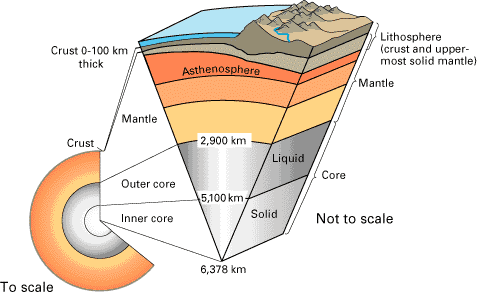
Diagram showing the location of the core and mantle relative to the earth's crust (Source: U.S. Geological Survey).
Thermal energy stored within the earth is known as geothermal energy. Energy can be transferred into or removed from rocks and sediment, and the resulting heat flow can be harnessed by engineered systems to produce electricity or to heat commercial buildings and homes.
Heat from deep within the earth results from a combination of thermal energy created during the formation of the earth and energy generated by the decay of radioactive elements (for example, uranium and thorium) in the earth's core and mantle (fig. 1). The thickness of continental crust in an area determines how readily deep-sourced heat flow can be used for power generation and direct use heating systems. In Indiana and much of the North American interior, relatively thick continental crust inhibits the economic feasibility of exploiting these high-temperature resources because of drilling costs and inefficiencies associated with circulating fluids to extreme depths (greater than 10,000 feet).
An alternative approach is to use stored thermal energy from the sun. The earth acts as a thermal battery and at relatively shallow depths (less than 500 feet) earth temperatures are generally stable and reflect the average annual air temperature. Geothermal heat pumps can extract thermal energy and transfer heat into buildings during winter months and inject excess heat back into the ground during summer months. By exchanging heat with the earth, properly designed systems are more efficient than conventional heating and cooling systems. A demonstration of this technology can be seen in the following video provided by the U.S. Department of Energy:
Current geothermal research at the IGS
At the IGS, we are studying deep geothermal conditions to evaluate basin heat flow and shallow geothermal conditions to improve efficiencies of geothermal ground-source heat pumps (GSHPs) in Indiana.
The Indiana Shallow Geothermal Monitoring Network
Although software exists for GSHP installers to calculate optimal lengths and configurations of ground-coupling geothermal systems, input parameters such as soil thermal properties and earth temperatures must first be determined for these applications to be optimal. The fundamental control on heat transfer for a ground-coupled heat pump system is the thermal conductivity of the earth materials within which the system is installed. Determining thermal properties for typical unconsolidated sediments in the upper 6 feet of the ground will support the design of more efficient systems by allowing GSHP installers to tailor the configurations of their in-ground systems to specific geological conditions and to account for seasonal fluctuations. For more information, see: Indiana Shallow Geothermal Monitoring Network.
National Geothermal Data System
The Indiana Geological and Water Survey is currently participating in a nationwide effort to build a National Geothermal Data System (NGDS). This project will facilitate the search for sources of renewable geothermal energy. State-specific geothermal data are being compiled into an integrated publically available (and searchable) national data system. For more information, see: http://geothermaldatasystem.org/. Geologists at the IGWS are also using these data to perform regional-scale hydrogeologic studies and evaluate carbon sequestration potential in the Illinois Basin. Several geothermal resource data sets compiled for use with geographic information software can be downloaded at the following IndianaMap Web site: http://maps.indiana.edu/layerGallery.html.


